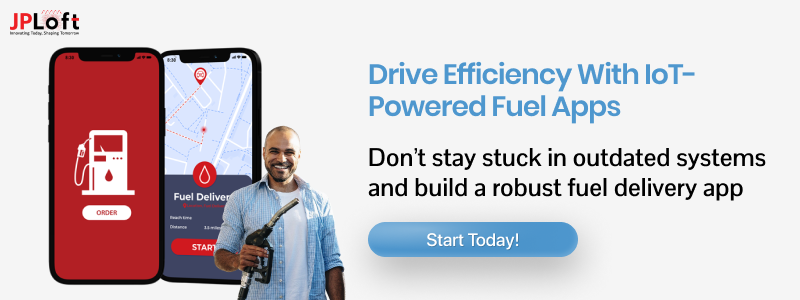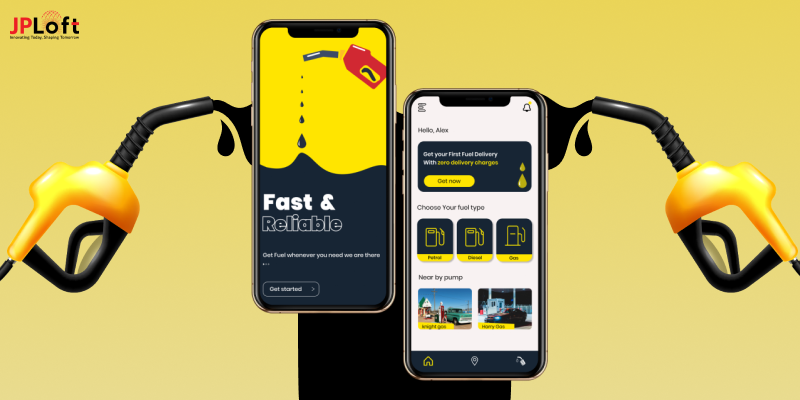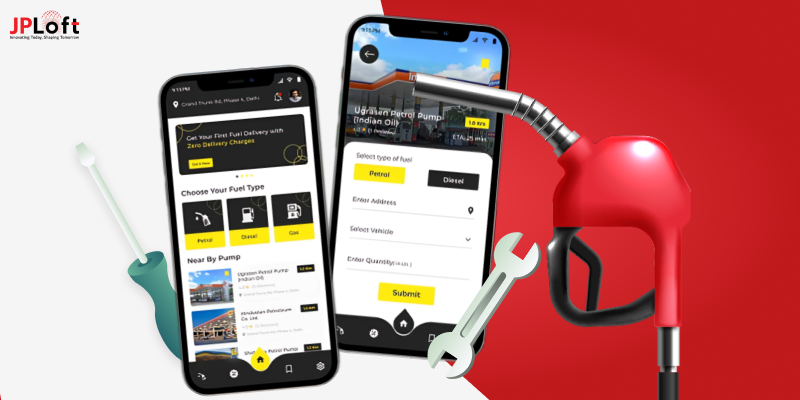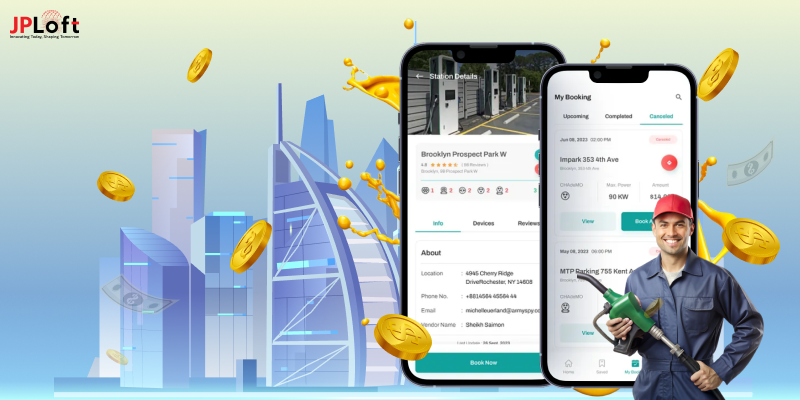Let’s be honest, no one likes waiting in long lines at petrol stations anymore.
With everything becoming on-demand, it’s no surprise that fuel delivery is catching up too. What’s even more exciting is how IoT in fuel delivery app development is changing the game.
From real-time vehicle tracking to smart fuel monitoring, IoT-enabled fuel delivery apps are turning traditional services into smart fuel delivery solutions.
If you are a startup or an enterprise, adding IoT software for fuel delivery can give your app a major edge. It’s not just about automation, it’s about creating a more reliable, efficient, and connected experience for both providers and users.
With a clear understanding of how IoT powers fuel delivery apps, it’s easy to see why businesses are quickly adopting this technology.
But what’s really driving this change? Let’s take a look at different aspects of the fuel delivery app industry to understand why now is the perfect time to innovate and invest in IoT-powered fuel delivery app development.
What is IoT and How It Works in Fuel Delivery?
Let’s keep it simple, IoT (Internet of Things) is basically a network of smart devices that talk to each other using the internet.
These devices collect, send, and receive data to help automate tasks, improve efficiency, and reduce human effort. From your smart fridge to GPS trackers, everything falls under the umbrella of IoT.
In the context of mobile apps, especially in industries like fuel delivery, IoT turns basic applications into intelligent, responsive systems. It’s the secret sauce behind smart fuel delivery solutions that are fast, accurate, and real-time.
Now, how does this work in fuel delivery apps?
Picture this: a customer orders fuel through an app, and thanks to IoT-powered fuel delivery apps, smart sensors in the delivery truck instantly track fuel levels, temperature, and delivery status.
GPS and route optimization software ensure fuel reaches the right place at the right time. The backend receives real-time data via sensors and devices, helping businesses make quick, smart decisions, whether it’s about routing, scheduling, or detecting a leak.
In short, the role of IoT in fuel delivery apps helps make operations smoother, safer, and smarter.
Fuel Delivery App Market Stats: Why It’s the Right Time to Innovate
The fuel delivery industry is rapidly evolving, with technology playing a pivotal role in its transformation.
Here are five compelling statistics that highlight how technological advancements are driving growth in this sector:
-
Significant Market Growth: The global fuel delivery market is projected to expand from $3.2 billion in 2024 to $12.5 billion by 2034, reflecting a robust CAGR of approximately 14.6%. This rise highlights how fuel supply is becoming more and more dependent on technologically driven solutions.
-
Rising Adoption of Tank Monitors: As per the Custom Truck’s report, over 50% of fuel delivery businesses are considering investments in tank monitoring technology. This trend indicates a focus on enhancing delivery efficiency and accurately monitoring fuel levels through technological means.
-
Emphasis on Mobile Technology: About 84% of fuel delivery companies acknowledge that their future software purchases depend critically on mobile capabilities, therefore showing the industry's shifts towards mobile technology to simplify processes and increase consumer involvement.
-
Projected Market Expansion: The mobile fuel delivery market is anticipated to grow at a CAGR of 7.3%, reaching $8.9 billion by 2031. Demand for handy, tech-enabled fuel delivery solutions drives this expansion.
-
Integration of Artificial Intelligence: Fuel delivery leaders are increasingly seeking easier and faster access to data, with a focus on integrating artificial intelligence to enhance decision-making processes and operational efficiency.
These figures clearly show that technology is not simply an add-on, but a primary engine of development and innovation in the fuel delivery sector.
Investing in innovative technical solutions is no longer a choice for firms that want to remain competitive; it's a must. Let’s see in the next section what are the benefits of IoT in fuel logistics.
Key Benefits of Integrating IoT in Fuel Delivery Apps
The fuel delivery industry is no longer just about bringing fuel from point A to point B.
With the power of IoT (Internet of Things), these services are getting smarter, faster, and more efficient. If you are building a fuel delivery app, adding IoT technology can completely change the game for you.
Let’s explore how benefits of IoT in fuel delivery apps can boost your business:
1. Real-Time Fuel Monitoring
One of the biggest benefits of IoT in fuel delivery app development is real-time tracking.
IoT-powered fuel delivery apps use smart sensors to keep an eye on fuel levels in storage tanks, delivery trucks, and even generators.
This helps in planning deliveries on time without running out or overstocking. This leads to fewer emergencies and smoother operations. Plus, users can get alerts when they need a refill automatically!
2. Smart Route Optimization
IoT-powered fuel delivery app development allows drivers to take the most efficient routes.
With GPS and traffic data integration, the app can adjust paths in real-time to avoid delays.
That means faster deliveries, reduced fuel consumption, and happy customers.
3. Better Safety and Compliance
Fuel is a hazardous material, and safety is key.
IoT software for fuel delivery helps monitor temperature, pressure, and tank conditions. If anything looks risky, the system sends out instant alerts.
This keeps both the driver and the fuel safe while ensuring you meet all government safety standards.
4. Improved Inventory and Stock Management
For fuel companies, knowing how much stock is available and where it’s going is essential. Smart fuel delivery solutions using IoT can track every drop.You get accurate data on fuel usage and deliveries with no guesswork, just clean, clear numbers.
5. Remote Diagnostics and Maintenance
With IoT integration, fuel delivery vehicles and equipment can send automatic updates on their condition.
This helps fix small issues before they become big problems and also reduces downtime and costly repairs.
6. Customer Convenience
For customers, a fuel delivery app with IoT integration brings ease. They can:
-
Schedule automatic deliveries
-
Track the tanker in real-time
-
Receive live updates and notifications
All this builds trust and improves customer satisfaction.
Now that we have explored the major benefits of using IoT in fuel delivery apps, it’s important to understand what actually makes these smart systems work.
Let’s break down the key components of IoT in fuel delivery apps that bring all these benefits to life.
Key Components of IoT in Fuel Delivery Apps
To understand how IoT-powered fuel delivery app development works, it’s important to know what makes up the Internet of Things (IoT) ecosystem.
At its core, IoT is built around four main components, each playing a crucial role in creating smart fuel delivery solutions.
-
Smart Sensors and Devices: These are the eyes and ears of your system. In IoT-driven fuel delivery apps, sensors are installed in fuel trucks, storage tanks, and delivery units. They monitor things like fuel levels, vehicle location, temperature, and pressure in real-time.
-
Connectivity: All those smart sensors need a way to talk to each other and the main system. This happens through Wi-Fi, mobile networks, Bluetooth, or satellite connections, allowing seamless IoT software for fuel delivery to function remotely and accurately.
-
Data Processing and Cloud Platforms: The data collected is sent to cloud-based servers where it's analyzed. This helps in decision-making, like which delivery route is fastest or when a refill is needed.
-
User Interface (App Dashboard): Finally, all insights are shown to the business owner or driver via a fuel delivery app with IoT integration, making the data easy to access and act on.
These components together create a smart, connected system that improves efficiency, reduces waste, and keeps operations running smoothly.
If you're planning to build a fuel delivery app with IoT integration, now’s the perfect time to explore how IoT-powered fuel delivery app development can help you start a fuel business.
Role of IoT in Fuel Delivery App Development
The role of IoT in fuel delivery app development goes far beyond just tracking a delivery vehicle. It brings automation, accuracy, and efficiency to the entire fuel supply chain.
Let’s break down how IoT in fuel delivery apps is truly changing the game:
► Real-Time Fuel Monitoring
With the help of smart sensors, top fuel delivery apps can keep a close check on fuel levels inside tankers and storage units.
This real-time data ensures there’s no shortage or wastage and lets the provider act immediately when fuel levels go too low or high.
► Live Vehicle Tracking
One of the strongest benefits of IoT-powered fuel delivery app development is live GPS tracking.
Businesses and customers can see exactly where the delivery vehicle is, its estimated time of arrival, and whether it's following the optimal route.
► Optimized Delivery Routes
Thanks to IoT software for fuel delivery, delivery routes can be optimized using real-time traffic updates, weather conditions, and fuel demand.
This helps save time, reduce fuel consumption, and increase the number of successful deliveries each day.
► Predictive Maintenance for Vehicles
One major benefit of IoT in fuel delivery app development is predictive intelligence.
IoT sensors can also monitor the health of delivery trucks. If something’s about to break down like engine failure or tire pressure issues, the app sends alerts. This proactive approach reduces downtime and ensures smooth, uninterrupted services.
► Safety and Leak Detection
IoT devices can detect abnormal pressure or leakage in the fuel tanks. If any danger is sensed, fuel delivery apps with IoT integration immediately alert the driver and operations team, reducing the risk of accidents.
► Data-Driven Business Decisions
By collecting and analyzing massive amounts of data, smart fuel delivery solutions help fuel companies understand customer demand, plan resources better, and even manage billing and fuel pricing more effectively.
► Inventory Management for Fuel Providers
IoT sensors play a crucial role in tracking the fuel inventory in real time whether it’s in delivery tankers, underground storage, or fuel stations.
With IoT software for fuel delivery, companies can avoid overstocking or stockouts, helping them manage supply more efficiently and reduce operational costs.
► Remote Diagnostics and Alerts
IoT-powered fuel delivery app development allows fuel companies to remotely diagnose issues with equipment, be it valves, sensors, or pumps without needing physical inspection.
This remote monitoring system helps reduce maintenance costs while increasing the fuel delivery app development cost. Also, it ensures timely repairs before small problems turn into big ones.
► Compliance and Regulatory Reporting
With all data being tracked and stored digitally, IoT in on-demand fuel delivery apps helps businesses stay compliant with industry safety and environmental regulations.
The system can auto-generate reports, monitor safe handling practices, and ensure every delivery meets government standards, saving time and reducing risks.
► Enhanced Customer Experience
For the end-user, IoT in on-demand fuel delivery apps means faster deliveries, accurate billing, fewer delays, and full transparency, everything they need for a smooth and satisfying service.
Understanding the role of IoT in fuel delivery app development gives you a clear picture of how this technology adds value to the industry. But the real game begins when you start building it.
So, let’s look at how to implement IoT in fuel delivery app development step by step.
How to Implement IoT in Fuel Delivery Apps?
Building a smart fuel delivery app with IoT integration involves more than just adding a few sensors.
It’s about creating an ecosystem that collects real-time data, responds intelligently, and makes operations smoother for both customers and providers.
Here’s a detailed look at how IoT in fuel delivery app development can be implemented step-by-step:
1. Define Your Objectives and Use Cases
Start by understanding what problems you want to solve. Do you want to track fuel delivery vehicles in real time? Monitor tank levels? Improve route optimization? Defining clear use cases will help shape your IoT-enabled fuel delivery app effectively.
2. Choose the Right IoT Hardware
Sensors and devices are the backbone of IoT-powered fuel delivery app development. You’ll need:
-
GPS trackers for live vehicle monitoring
-
Fuel level sensors to prevent shortages or wastage
-
Temperature and pressure sensors for fuel safety.
These devices are essential to enable smart fuel delivery solutions and ensure accurate, real-time monitoring.
3. Select Compatible IoT Software for Fuel Delivery
The software you use should be able to communicate with your IoT devices, process incoming data, and generate actionable insights. Cloud-based platforms are often used to support large volumes of real-time data in IoT in on-demand fuel delivery apps.
4. Integrate with Mobile and Web Apps
Your IoT data should reflect instantly within your app.
For example, if a tank is running low or a vehicle is stuck in traffic, users should get live updates. This is where fuel delivery apps with IoT integration truly shine offering transparency and smart notifications.
5. Enable Predictive Analytics
With historical and live data, the app can forecast demand, suggest restocking schedules. Enabling this feature can even help reduce fuel theft or loss.
This is especially important in large-scale operations where smart decisions save time and money.
6. Focus on Data Security
With sensitive data like location and fuel consumption being constantly collected, security is key.
Encrypt your IoT systems and ensure your app complies with industry data protection standards. Trust and privacy are non-negotiable for smart fuel delivery solutions.
7. Test in Real-Time Environments
Before going live, simulate real-world fuel delivery scenarios to test the responsiveness and reliability of your IoT system. Fine-tuning your IoT software for fuel delivery during testing ensures your app works smoothly when customers need it most.
8. Ensure Scalable Infrastructure
As your operations grow, your IoT-powered fuel delivery app should grow with you. Cloud storage, modular architecture, and update-ready software will allow you to scale up without disruptions.
Now that you know how to implement IoT in a fuel delivery app, let’s take a look at how this technology is already transforming the industry through real-world examples and smart use cases.
Real-World Use Cases of IoT in Fuel Delivery Apps
When it comes to fuel delivery apps, IoT (Internet of Things) isn’t just a buzzword; it’s the tech backbone that makes everything smart, efficient, and reliable.
From the moment a user places an order to the second fuel is delivered at their doorstep, IoT in fuel delivery apps ensures the entire journey is seamless.
Let’s break down how this smart tech actually works inside a fuel delivery app:
A] Live Vehicle and Fuel Tank Tracking
Using IoT sensors, the app tracks the location of the fuel delivery vehicle in real-time.
This helps customers know exactly when their delivery will arrive, and businesses can monitor fleet movement efficiently.
Real-time vehicle and fuel tracking using IoT also helps in optimizing routes and reducing delays, giving users a smooth experience while cutting operational costs.
B] Smart Fuel Level Monitoring
One of the smartest fuel delivery app features is automated fuel level detection.
For bulk deliveries or commercial fuel services, sensors in tanks can detect fuel levels and notify both customers and delivery agents when it’s time for a refill. This automation adds to better planning and zero guesswork.
C] Predictive Maintenance for Delivery Vehicles
The same IoT software for fuel delivery can also monitor the health of delivery vehicles.
It checks engine performance, tyre pressure, and wear-and-tear data, helping companies prevent breakdowns and keep services running on time. This boosts customer trust and keeps maintenance costs low.
D] Real-Time Safety Monitoring
Fuel is a sensitive material to transport. IoT-enabled fuel delivery apps come with sensors that detect temperature changes, leaks, or unusual pressure inside the tank.
If something goes wrong, the system alerts the operator instantly. This makes IoT-based fuel delivery apps much safer for both drivers and customers.
E] Optimized Route Management
With live GPS and smart algorithms, IoT for fuel delivery management can suggest the shortest, fastest, and least congested delivery routes.
This doesn’t just save time, it also improves fuel efficiency of the delivery trucks. It’s an ideal feature for businesses looking for smart fuel delivery solutions.
F] Inventory Control for Vendors
For companies managing multiple refuelling trucks or storage tanks, IoT in logistics and fuel tracking offers a clear picture of stock levels across locations.
The app shows current fuel quantity, usage trends, and refill needs, helping with better supply planning.
G] Enhanced User Experience
From instant updates to delivery confirmation and transparent fuel tracking, users feel more in control.
The app isn’t just a delivery platform it becomes a smart dashboard for both users and vendors. This is where IoT integration in fuel apps truly shines, delivering convenience and trust in every tap.
H] Data-Driven Decision Making
Every time someone uses the app, valuable data is collected about delivery times, user behaviour, refuelling frequency, and more.
This allows businesses to improve services and offer custom deals, making their app more user-friendly. That’s why many businesses are leaning towards IoT-enabled fuel delivery apps to stay competitive.
While these real-world applications highlight the power of IoT in fuel delivery apps, integrating this technology isn't always smooth sailing.
Let’s explore some common challenges businesses face during development and how to overcome them.
Challenges You May Face While Integrating IoT in Fuel Delivery Apps
While IoT in fuel delivery app development brings a world of innovation and automation, integrating it isn’t always a walk in the park. Businesses often face some common challenges when trying to build or scale IoT-enabled fuel delivery apps.
Let’s go through a few of them and how you can handle them smartly.
► High Initial Development Cost
Creating a fully functional fuel delivery app with IoT integration can demand a higher upfront investment due to hardware (sensors, GPS, monitoring tools) and custom software requirements.
Quick Fix: Start with an MVP (Minimum Viable Product) focused on essential IoT features and scale gradually as demand grows.
► Data Security and Privacy Concerns
IoT devices constantly collect data, vehicle locations, user behaviour, and fuel usage. Without proper security measures, this data can be vulnerable to cyberattacks.
Quick Fix: Use secure IoT protocols and encrypt data transmission. Ensure your app meets app security measures.
► Hardware Compatibility Issues
One of the underrated challenges in IoT-powered fuel delivery app development is making sure all devices and sensors work well with your app’s software. Compatibility issues can lead to delays and inaccurate readings.
Quick Fix: Choose widely supported IoT hardware and hire dedicated developers to ensure smooth integration.
► Real-Time Connectivity
IoT in on-demand fuel delivery apps relies heavily on real-time communication. In areas with poor network connectivity, delays in data syncing can affect user experience.
Quick Fix: Implement offline features or edge computing, where the device can temporarily function without real-time server access and sync later.
► Scalability Challenges
As your operations grow, managing multiple devices, trucks, and data streams can become complex. Without proper architecture, the system may lag.
Quick Fix: Build the app using scalable cloud platforms that support bulk IoT data management from the start.
While these hurdles may seem overwhelming, they’re not deal-breakers. With the right planning, tech partners, and tools, businesses can still tap into the full potential of IoT software for fuel delivery.
In the end, the benefits of smart fuel delivery solutions far outweigh the initial challenges and pave the way for long-term efficiency and customer satisfaction.
To stay ahead, it’s also important to look at the latest fuel delivery app trends and how IoT is driving the future of this industry.
Future Trends of Smart Fuel Delivery: How IoT is Shaping What Comes Next
The fuel delivery industry is entering a new era, and IoT in fuel delivery app development is playing a huge part in shaping it. As technology keeps evolving, fuel delivery apps are expected to become smarter, faster, and even more reliable.
One major trend is predictive fuel management. With real-time data from sensors, IoT-powered fuel delivery app development will help businesses predict fuel demand, optimize delivery routes, and reduce waste. This means fewer delays, better planning, and happy customers.
Another exciting shift is towards AI in fuel delivery apps along with IoT software integration. These systems can learn from past deliveries, weather conditions, and traffic to improve decisions automatically.
As environmental concerns grow, IoT will also support eco-friendly smart fuel delivery solutions, like tracking emissions and reducing idle times. This aligns with the global move toward greener logistics.
We’ll also see better user experience. With features like real-time tracking, fuel level alerts, and instant notifications, fuel delivery apps with IoT integration will offer more control to users and transparency into every step of the delivery.
The future looks promising, and embracing these innovations now means staying ahead in a competitive market.
How JPLoft Can Help You Build an IoT-Enabled Fuel Delivery App?
If you are planning to create a powerful, reliable, and future-ready fuel delivery app, JPLoft is the partner you can trust. As a top fuel delivery app development company, we specialise in building smart, scalable, and secure solutions powered by the latest technologies, including IoT.
Our team understands the ins and outs of IoT-enabled fuel delivery apps, from integrating real-time tracking and fuel sensors to setting up intelligent dashboards and predictive analytics.
We design apps that not only offer seamless fuel ordering but also give users and operators full control and visibility over their operations.
If you are starting from scratch or upgrading your existing system, we will help you implement the right tech stack, customise the features to your needs, and ensure smooth performance across all devices.
With a proven track record and strong domain expertise, JPLoft helps you build apps that are ready for today and tomorrow.
Let’s build a smarter fuel delivery future, together.
Conclusion
IoT is truly revolutionizing the way on-demand fuel delivery apps operate.
From real-time vehicle tracking to predictive maintenance and fuel level monitoring, IoT brings smarter, safer, and more efficient solutions to the table.
As the demand for seamless and tech-driven services grows, integrating IoT in fuel delivery app development is no longer optional; it’s essential.
Whether you’re aiming to improve logistics, boost user experience, or stay ahead of the competition, investing in IoT-enabled fuel delivery app development is the way forward.
With the right tech partner like JPLoft, you can turn your app idea into a powerful, future-ready solution that delivers real value both for your business and your customers.
FAQs
IoT (Internet of Things) in fuel delivery apps refers to the use of connected devices, sensors, and software to automate, track, and optimise fuel ordering, dispatching, and delivery processes in real time.
IoT enables real-time vehicle tracking, fuel level monitoring, route optimisation, and predictive maintenance. It improves delivery accuracy, reduces fuel wastage, and enhances overall customer satisfaction.
Some key benefits include smart fuel delivery solutions, real-time tracking, safety and compliance, reduced operational costs, better fleet management, and improved user experience.
Yes, when implemented with secure IoT software for fuel delivery, the technology ensures encrypted communication, secure device access, and safety monitoring to prevent accidents or data breaches.
Features include real-time tracking, sensor-based fuel level detection, automated dispatching, route optimisation, digital payments, and predictive analytics.













Share this blog